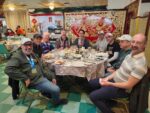Report Takes Aim at ‘Model Minority’ Stereotype of Asian-American Students
The image of Asian-Americans as a homogeneous group of high achievers taking over the campuses of the nation’s most selective colleges came under assault in a report issued Monday.
The report, by New York University, the College Board and a commission of mostly Asian-American educators and community leaders, largely avoids the debates over both affirmative action and the heavy representation of Asian-Americans at the most selective colleges.
But it pokes holes in stereotypes about Asian-Americans and Pacific Islanders, including the perception that they cluster in science, technology, engineering and math. And it points out that the term “Asian-American” is extraordinarily broad, embracing members of many ethnic groups.
“Certainly there’s a lot of Asians doing well, at the top of the curve, and that’s a point of pride, but there are just as many struggling at the bottom of the curve, and we wanted to draw attention to that,” said Robert T. Teranishi, the N.Y.U. education professor who wrote the report, “Facts, Not Fiction: Setting the Record Straight.”
“Our goal,” Professor Teranishi added, “is to have people understand that the population is very diverse.”
The report, based on federal education, immigration and census data, as well as statistics from the College Board, noted that the federally defined categories of Asian-American and Pacific Islander included dozens of groups, each with its own language and culture, as varied as the Hmong, Samoans, Bengalis and Sri Lankans.
Their educational backgrounds, the report said, vary widely: while most of the nation’s Hmong and Cambodian adults have never finished high school, most Pakistanis and Indians have at least a bachelor’s degree.
The SAT scores of Asian-Americans, it said, like those of other Americans, tend to correlate with the income and educational level of their parents.
“The notion of lumping all people into a single category and assuming they have no needs is wrong,” said Alma R. Clayton-Pederson, vice president of the Association of American Colleges and Universities, who was a member of the commission the College Board financed to produce the report.
“Our backgrounds are very different,” added Dr. Clayton-Pederson, who is black, “but it’s almost like the reverse of what happened to African-Americans.”
The report found that contrary to stereotype, most of the bachelor’s degrees that Asian-Americans and Pacific Islanders received in 2003 were in business, management, social sciences or humanities, not in the STEM fields: science, technology, engineering or math. And while Asians earned 32 percent of the nation’s STEM doctorates that year, within that 32 percent more than four of five degree recipients were international students from Asia, not Asian-Americans.
The report also said that more Asian-Americans and Pacific Islanders were enrolled in community colleges than in either public or private four-year colleges. But the idea that Asian-American “model minority” students are edging out all others is so ubiquitous that quips like “U.C.L.A. really stands for United Caucasians Lost Among Asians” or “M.I.T. means Made in Taiwan” have become common, the report said.
Asian-Americans make up about 5 percent of the nation’s population but 10 percent or more — considerably more in California — of the undergraduates at many of the most selective colleges, according to data reported by colleges. But the new report suggested that some such statistics combined campus populations of Asian-Americans with those of international students from Asian countries.
The report quotes the opening to W. E. B. Du Bois’s 1903 classic “The Souls of Black Folk” — “How does it feel to be a problem?” — and says that for Asian-Americans, seen as the “good minority that seeks advancement through quiet diligence in study and work and by not making waves,” the question is, “How does it feel to be a solution?”
That question, too, is problematic, the report said, because it diverts attention from systemic failings of K-to-12 schools, shifting responsibility for educational success to individual students. In addition, it said, lumping together all Asian groups masks the poverty and academic difficulties of some subgroups.
The report said the model-minority perception pitted Asian-Americans against African-Americans. With the drop in black and Latino enrollment at selective public universities that are not allowed to consider race in admissions, Asian-Americans have been turned into buffers, the report said, “middlemen in the cost-benefit analysis of wins and losses.”
Some have suggested that Asian-Americans are held to higher admissions standards at the most selective colleges. In 2006, Jian Li, the New Jersey-born son of Chinese immigrants, filed a complaint with the Office for Civil Rights at the Education Department, saying he had been rejected by Princeton because he is Asian. Princeton’s admission policies are under review, the department says.
The report also notes the underrepresentation of Asian-Americans in administrative jobs at colleges. Only 33 of the nation’s college presidents, fewer than 1 percent, are Asian-Americans or Pacific Islanders.






